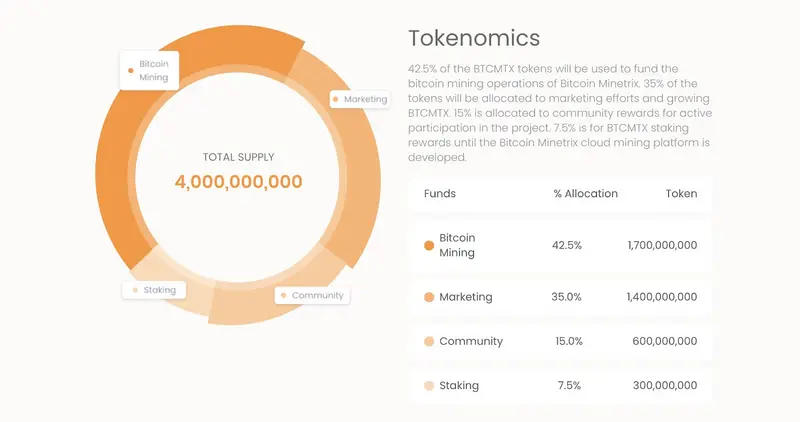New Crypto Staking Platform ‘Bitcoin Minetrix’ Launches Token ICO, Raises $100,000 Day One

With the highly-anticipated Bitcoin halving - scheduled for April of next year - quickly approaching, the spotlight is once again on Bitcoin, mining and additional ways to generate profits in the crypto market.
The new crypto staking and cloud mining project Bitcoin Minetrix project is ensuring that ordinary investors can once again be a part of the Bitcoin mining sector, which has lately been increasingly dominated by giant corporations.
Thanks to this unique value proposition, the Bitcoin Minetrix presale has already hit the $100k milestone in less than 24 hours since launching - this explosive start to its ICO signifies a robust demand for the project, which could easily make it one of the most attractive buys for the next bull run.
Bitcoin Minetrix - Introducing Decentralization To BTC Mining
Perhaps the most important aspect of Satoshi Nakamoto’s Bitcoin Whitepaper is its focus on decentralization, highlighting the importance of a peer-to-peer global financial system that is not monopolized by one or two powerful entities.
In its early days, Bitcoin did strictly adhere to this principle - any enthusiast with a computer and a CPU could mine BTC tokens, while also contributing to the safety of the network.
Every Bitcoin buff has heard the story of Laszlo Hanyecz, the man who offered 10,000 BTC tokens for two large pizzas. He has been the butt of many jokes - after all, those two pizzas would be worth $263 million.
However, what people often miss about the story is that Hanyecz was one of the first people to realise that a Graphics Processing Unit or GPU is much more suitable for BTC mining than a CPU. He also created the first mining software for MacOS systems. In fact, the 10,000 BTC tokens exchanged for the two pizzas were mined by Hanyecz himself.

Today, unfortunately, it is impossible for an ordinary BTC enthusiast with a GPU to mine 10,000 BTC tokens. The current-day BTC mining industry is marked by mining pools - a group of wealthy companies that combine their computational resources together. Even then, there is little competition between these pools as behemoths like Foundry and Antpool are often responsible for more than half the blocks created.
To combat this, Bitcoin Minetrix has come up with a cutting-edge cloud mining solution that can restore the power back into the hands of people. The project has a simple motto, “Bitcoin Minetrix mines Bitcoin, so that you don’t have to.”
Investors can simply purchase $BTCMTX tokens, preferably during the presale, and stake them to earn mining credits, which can eventually be burnt to mine BTC and earn rewards.
How Bitcoin Minetrix Is Superior Than Other Cloud Mining Solutions?
Cloud mining is not altogether a novel trend - the concept not only offers retail investors a fair chance in the competitive mining industry, but it also eliminates the need for any technical expertise. Investors also do not have to deal with the immense heat and noise generated by mining rigs. They can simply rent the computational power or the hardware equipment, which is then operated by a third party.
However, the space is rife with scam projects that do not intend to keep their too-good-to-true promises. Legacy cloud mining companies like Fancy Crypto, Happy Miner and IDMining have all engaged in questionable behaviours such as demanding more deposits and pausing withdrawals.
Furthermore, the industry is also dominated by centralised operators, leading to a lack of legitimacy in the entire process, which does not line up with Satoshi Nakamoto’s vision.
On the other hand, Bitcoin Minetrix has adopted the Stake-to-Mine mechanism - a variation of the popular proof-of-stake consensus mechanism - to offer a tokenized and superior version of cloud mining, one that is marked by higher transparency. Under this model, investors can stake their BTCMTX tokens in an Ethereum-powered smart contract to receive mining credits.
These mining credits are non-transferable ERC-20 tokens - a strategy that ensures that they are not compromised - and can be burned either for BTC cloud mining time or for a percentage of the yields. The more mining credits one burns, the more BTC tokens they will earn as rewards.

This decentralised method eliminates the need for cash contracts that are all too common in the mining industry, giving users full autonomy over their funds.
Community-centric Tokenomics, Lucrative Staking Rewards
Bitcoin mining is one of the most profitable businesses, especially during a bull run when investors start to increase their BTC holdings and the number of on-chain transactions starts to surge. As such, the cryptocurrency mining industry is expected to balloon to $7 billion by 2032 and a project like Bitcoin Minetrix - thanks to its revolutionary decentralized approach - could be one of the biggest beneficiaries.
To take maximum advantage of this oncoming boom, the project has adopted community-focused tokenomics to maximise its user adoption. 42.5% of the token supply will be used to fund Bitcoin Minetrix’s cloud mining operations, while 7.5% of the tokens will be used to distribute staking rewards - this allows investors to generate passive income even before the project’s mining platform is developed.

35% of the $BTCMTX supply will be used to support the project’s marketing efforts, so that the investors previously disaffected by legacy and scam cloud mining projects can receive a second opportunity. The remaining 15% of the tokens will be distributed as community rewards.
The Bitcoin Minetrix presale has a stage one target of $3.08 million, with close to $110k worth of tokens already sold out. Thus, investors looking to grab the token at a cheap price of $0.011 have a limited window before it explodes after the launch.
Comments
Post a Comment